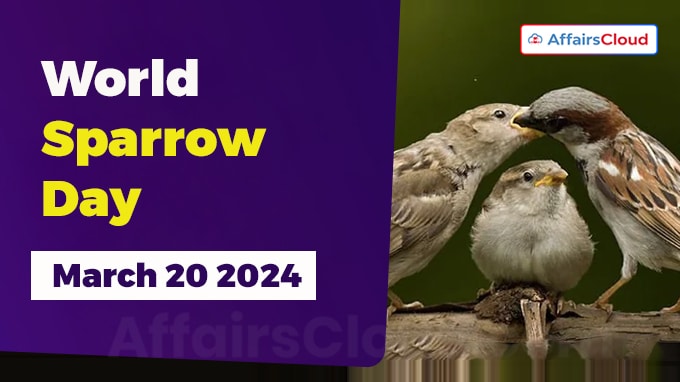 World Sparrow Day (WSD) is annually observed across the globe on 20 March to raise awareness about the importance of sparrows or house sparrows (Passer domesticus) for biodiversity and the ecosystem, and to promote actions to protect and conserve them.
World Sparrow Day (WSD) is annually observed across the globe on 20 March to raise awareness about the importance of sparrows or house sparrows (Passer domesticus) for biodiversity and the ecosystem, and to promote actions to protect and conserve them.
- The Day was initiated to advocate for the conservation of House Sparrows and common bird species and highlight the significance of celebrating biodiversity.
Theme:
The theme for WSD is “I LOVE Sparrows”. The theme is inspired by the hope that more people will celebrate the relationship between People and Sparrows.
Background:
i.The initiative of celebrating World Sparrow Day was a collaborative effort of the Nature Forever Society (NFS) of India, founded by Environmentalist Mohammed Dilawar; the Eco-Sys Action Foundation of France; and other national and international entities.
ii.The first World Sparrow Day was celebrated in 2010 and has been celebrated in over 40 countries across the globe.
About House Sparrow:
i.House Sparrow has been transported worldwide by European settlers and can now be found on two-thirds of the world’s land masses.
ii.It is a native of Europe, Asia, and Northern Africa and inhabits regions like New Zealand, Australia, North America, India, and Europe.
iii.Absent from areas like China, Indochina, Japan, parts of Siberia, and Australia to the east, and tropical Africa and northern areas of South America to the west.
iv.The House Sparrow was introduced in Brooklyn, New York, the United States of America (USA) in 1851.
v.It is a social species, found in groups of 8 to 10, and plays a role in the functioning of ecosystems by maintaining the food web and an ecological balance.
vi.It primarily feeds on seeds and kitchen scraps. However, young chicks depend on insects like aphids and caterpillars.
IUCN Red List:
i.Due to its declining population, the International Union for Conservation of Nature (IUCN) included the house sparrow (Passer domesticus) among its list of “Endangered” species in 2002.
ii.The house sparrow was assessed and the IUCN listed it as a “Least Concern” species in 2018, indicating a population rebound.
Declining Factors:
Various factors contribute to the decline, including habitat destruction, scarcity of insect food for the young, and the potential impact of microwave pollution from mobile phone towers.
Conservation Efforts in India:
i.Mohammed Dilawar and other bird enthusiasts campaigned for house sparrow conservation in Nashik (Maharashtra) and other parts of India.
- For his efforts, Dilawar was honoured as “Hero of the Environment” by Time magazine in 2008.
ii.Delhi declared the house sparrow as the state bird and mascot on August 14, 2012.
iii.Bihar cabinet declared the house sparrow as the state bird on April 17, 2013.
Initiatives:
Non-profits like the Bombay Natural History Society (BNHS) in Mumbai (Maharashtra) and other groups and individual environmentalists, along with the Union Ministry of Environment, Forest and Climate Change (MoEF&CC) started the “Citizen Sparrow” project on April 1, 2012.
- Aimed to gather data on sparrow populations, historical range, and decline factors.




